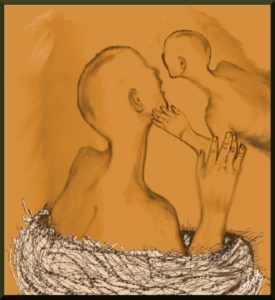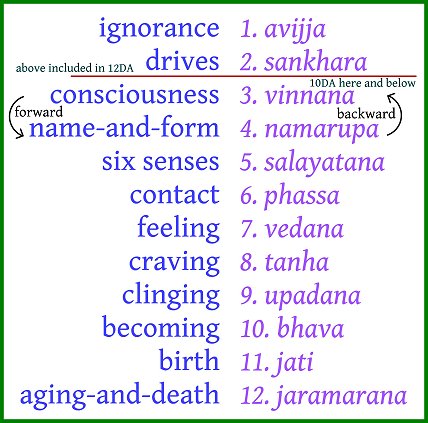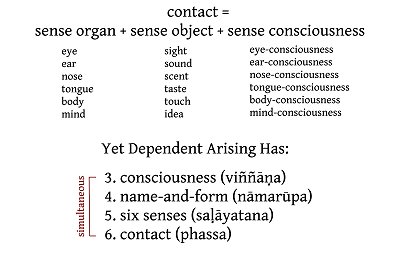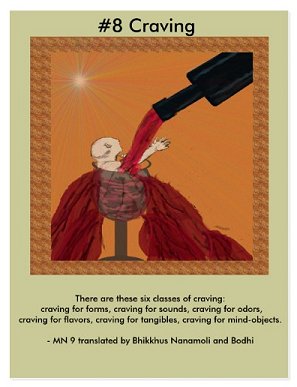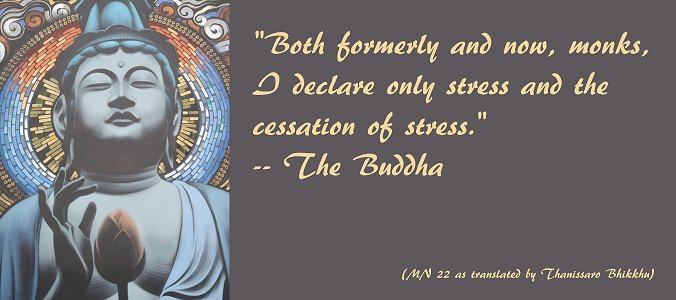
This really is going to be a post about saṅkhārā, honest it is, and soon. But first, I need to cover two personal points. #1 is to say this is a blog, and I’m a writer and a story-teller who specializes in conveying my own life in my writing. In the case of what I write here, my blog is representative of how much my study of early Buddhism is part of my life. Not just the practice — lots of people write about how practice affects their lives, valuable writing which I admire — but about the study and what I find. #2 is to say that the more I study the Buddha’s descriptions of dependent arising (DA), the more I see what he did with those descriptions, the more in awe of him I am, of not just his insight (which is phenomenal and useful) but of the thought he put into conveying it, and the way he structured it within the context of the tools he had available. Those two “about me” points are combined in what follows.
I despair of my ability to convey what I see of the Buddha’s teaching.
Over most of the last decade I’ve been terribly, unaccountably disabled by some mystery illness the doctors haven’t yet identified, often wishing I’d just die and be done with it. But this view of the Buddha’s teaching — how clear it is, how useful, how beautiful — has effectively served as my will to live. I couldn’t hold it together enough to research, take notes, and write, but I could still read, still think about it, still practice it.
I’m feeling modestly better now, and in my good moments am thrilled to be back to work, but even at my best I keep finding that there is so much depth the Buddha put into DA that even if my audience was as familiar with the context as his was, I might be inadequate to the task of explaining it all. So you can see why I’m in awe of the Buddha’s abilities.
But I have a couple of extra-added complications he didn’t have. One is that my audience doesn’t have the context his did, so on top of trying to describe the depth and complexity he put into DA, I have to explain how differently his audience thought about the workings of the world — like their understanding that a fire, having been extinguished, does not cease to exist. This is very different from the way we think of things. In addition to the difference in worldview, I need to convey the meanings of words the Buddha used, and the multi-layered meanings intended to be understood quite differently from our “I mean only definition #3 when I use that word” sort of thinking. They intended to call to mind many layers of meanings of the words they used; we tend to limit ourselves to one.
On top of all that, the majority of my “audience” is justifiably skeptical of what I’m trying to convey, and — as the Buddha is trying to tell us with dependent arising — the firmly-held views people hold tend to block our ability to fully understand what’s being described about different views. He says ignorance begets more ignorance. I’d translate that as covering “biases breed support for biases.”
That said, I’m going to keep trying to express what I see. I have in mind the possibility that I may not last (I’m getting old) until I’ve worked it all into a cohesive book. That being the case, I’m going to try to get some of the pieces into public view in this blog. Today my focus is on a word I’ve covered here before, this time offering another view of it that deepens the insights into this understanding of dependent arising, its composition and content.
Saṅkhārā As Rituals of Self-Creation
It’s been my understanding for many years now that the most difficult-to-translate word in Pali, as used in DA, is saṅkhārā (saṃskāra in Sanskrit). It was used by the Buddha as a representative term for the second link in the chain of events that is dependent arising. It seems he used it, specifically, because during the time he lived it was well-known and in frequent use. Its meaning was, then as even now in Hindi, “ritual”, a ritual of a particular type used for a specific purpose. As Brian K Smith puts it in his book on Vedism, “Reflections on Resemblance, Ritual, and Religion” in a section labelled “Constructing Selves and Statuses” (pages 91-101):
Following the ritual philosophers, then, one might best consider these rituals not as rites of passage — implying leaps from one ontologically stable condition to another — but rather both as rituals of healing… and as rituals of construction. From conception to birth, from birth to the “second birth” of initiation, and from marriage to death, the life of the Vedic male was punctuated by these rituals of healing and formation, of transformation and transfiguration.
Then, when discussing the upanayana as “perhaps the most important” of the series of these rituals, Smith says:
It appears that at a very early date in Vedic history the upanayana and subsequent period of Veda study were regarded as mandatory for the Aryan community. By the time of the Sūtras, the upanayana was called simply the saṃskāra to indicate its paradigmatic significance…
Upanayana initiated a young boy into the study of the Veda under the guidance of a teacher and into the performance of the sacrifice… he became, by virtue of the rite, “twice born” (dvija), a term that occurs as early as the Atharva Veda Saṃhitā… This second birth was thus claimed to be a socio-ontological birth standing in radical opposition to the defective natural birth, and was designed to rectify biological faults and construct a higher ontological existence for the young boy…
In this way, the natural birth of individual humans replicates the natural birth of the cosmos as a whole, for both are regarded as equally degenerate. And just as we understood the cosmogonic myths as statements of the ineptitude of Prajāpati, the creator god, so might we understand the denigration of natural birth as statements of the ineptitude of human mothers. The ritualists felt that only they were ultimately qualified to produce proper offspring; both the cosmos and individual humans could be “truly born” only from a womb controlled by priests, from the womb, that is, of the sacrifice.
At the start of this section of his book, Smith notes that the term saṃskāra doesn’t appear in Vedic works until the Sūtras, composed from about 700 BCE to 300 BCE. This means it’s very likely the Buddha — living at some point during that time — taught in a period when the word was in popular use. Smith also says that even before that word’s appearance, “other formations of sam– + kṛ describing the effects of rituals on humans do appear regularly in the Veda, and with much the same meaning.” He cites instances in the ṚgVeda and Śatapatha Brāhmaṇa.
I would suggest that the Buddha didn’t invent the word saṅkhārā out of nowhere to mean “formations” or “volitional actions” or any of the various translations we’ve come up with. He didn’t invent it and then have it start appearing in the Sūtras, adopted there with a quite different meaning from his. No, clearly the term was already in existence, referring to rituals of self-construction, and he included it because rituals of self construction were exactly what he needed as a model to describe our creation of a self via the process of dependent arising.
On page 100 Smith says, “The upanayana delivers a reborn Āryan, who was supposedly more really human because more fully realized, activated through the activity of ritual.”
This is, I believe, what the Buddha was asking his audience to include in their thinking when he began including the term saṅkhārā in his classic versions of dependent arising. Those concepts of “realized” and “activated” will play a part in these posts, here, and in upcoming discussions of consciousness and name-and-form, the representative terms that follow saṅkhārā in DA, because the concept of forces that are not yet manifested as different from those which have had an effect in the world — manifest, real, active — are critical to understanding those two following terms in particular.
In its place as the second link in dependent arising — preceded only by ignorance (avijjā) as a many-layered term clearly making reference to its opposite, “Veda” which represents knowledge — those two starting terms are so clearly intended to get listeners to recognize that the Buddha is talking about rituals of construction that it would have been hard to miss in his day. However, quite easy to miss later when those trying to understand the teachings were not connecting them to the Brahmanical world. (Note especially that during the period when King Ashoka popularized Buddhism a century or two after the Buddha’s death, Brahmins and their teachings were very likely not as much a part of common culture.)
What Are Rituals, Really?
What the term saṅkhārā should tell us is that the Buddha’s audience was already familiar with the idea of creating and perfecting a self other than the most basic version of self, understood as a physical individual. The rituals that were present in a certain segment of the population were very likely at least as well-known to those outside that group as concepts of confession or baptism are to those of us who are not Catholics or Baptists nowadays. The idea of “a second birth” within one lifetime, too, would have been familiar, and so it is logical to see the Buddha as calling on those rituals that affected that non-physical “self” — the ātman — to try to get people to recognize that what’s being created in those rituals and (critically) other rituals that parallel those is, because of our ignorance, not exactly what we think it is, and not good for us: dukkha-producing.
The rituals the Buddha was clearly referring to are things we are told by society, and by our family and friends, are beneficial because they’re based on a correct understanding of how the world works. Though the Buddha was using rituals well-known in his time to do just that — Vedic rituals used by the Brahmins and believers in their ways — I am certain he was not intending to limit the application of his teaching to those folks, to Brahmins and believers. He was using the loose definition of those rituals (as I describe it in the first sentence in this paragraph) to address all such rituals: all the habits of thinking we employ — in our ignorance — because they seem beneficial, because those we trust tell us they are right and good and are based on a correct understanding of the way the world works.
Rituals are the things we do often without thinking much about why we do them: habits. As much as we believe they are good things — whether that’s good in the sense of comforting (like going out for a cigarette in times of stress) or good in the sense of bringing us good fortune in the future (repeating affirmations, brown-nosing the boss) makes no great difference. They are things we do without giving very deep thought to most of them. And as much as we are confident they’re okay enough to keep doing them, thinking we control them, yet they shape us, usually without us noticing how much our justification of some of them are entirely embedded in what we’ve been told.
This is, I feel sure, what the Buddha is talking about, what he wanted us to notice when he added saṅkhārā (and ignorance) on to his already quite useful 10-link DA.
Saṅkhārā As Craving, Craving As Saṅkhārā
I have suggested elsewhere (a decade ago) that the first five links of dependent arising are two things. (1) They are references to the Prajāpati myth that underlies the Vedic rituals like the saṅkhārās. (2) They are not so much active links as they are driving forces. I call them “The Givens”: given that we’re ignorant of all that follows, given that we have a drive to exist and keep existing, given that to satisfy that drive we have to have a mind capable of knowing we exist, given that that mind needs information to know we exist, given that our senses try to provide us with that information, all those drives to exist and know we do will cause us to behave in ways that follow those early links. The links in “The Givens” take their shape from the Prajāpati myth, so those two concepts are intertwined.
But those first five links also create another pattern: they are overviews of what follows, a summary. (This is what I mean by how much layering and how much depth the Buddha packs into this one lesson. In summary it is quite simple, but explaining how he conveys it takes a lot of complexity.)
Saṅkhārā definitely points to Vedic rituals but it also points to the Prajāpati myth and other similar creation myths from that culture in which the cosmos comes into being from pure desire. On one level that pure desire is likely sexual lust, and on that same level and at the same time stepping up, it’s pure desire for existence, in particular for one’s own existence to continue through one’s children (well, in those days: sons). Procreation is the model for those creation myths, and the creation myths are tied to the rituals of creation and perfection of the ātman — it’s all one completely intertwined reference to desire — to which the Buddha is adding yet another layer of discussion about how it is our desire to exist, to thrive, that is driving our rituals and habits (that lead to dukkha, not bliss).
So while saṅkhārā is meant to call the literal rituals of his day to mind, it also represents craving for existence on all those levels.
As evidence that this is so, I offer a sutta which might represent an early form of dependent arising. In this sutta, saṅkhārā (rituals/desire/craving) and taṇhā (which we translate as craving) switch places. Craving is usually link #8, whereas here it is a stand-in for link #2.
If, bhikkhus, there is lust for the nutriment edible food, if there is delight, if there is craving, consciousness becomes established there and comes to growth. Wherever consciousness becomes established and comes to growth, there is a descent of name-and-form. Where there is a descent of name-and-form, there is the growth of volitional formations. Where there is the growth of volitional formations, there is the production of future renewed existence. Where there is the production of future renewed existence, there is future birth, aging, and death, I say that is accompanied by sorrow, anguish, and despair.
DA in its classic 12-link version has 1. ignorance 2. saṅkhārā 3. consciousness 4. name-and-form 5. six senses 6. contact 7. feeling 8. craving 9. clinging 10. becoming 11. birth 12. aging-and-death.
In the above sutta we start from a little further back — with eating and delight — but what’s important is that craving immediately precedes consciousness, so it is standing in saṅkhārā’s usual place. I say that’s fine because saṅkhārā is craving (for existence, craving that takes many forms). Consciousness and name-and-form take their usual order. Then a few steps appear to be missing, but I don’t think they are actually missing, because next is “volitional formations” — a translation of saṅkhārā — in a very unusual position. This, I say, is also fine, because saṅkhārā in its “overview” position represents the rituals we do every day, over and over again, that create and modify our selves, and that is what the middle portion of DA details in its classic version. So saṅkhārā, here, is holding the place of contact, feeling, craving, and clinging. This is followed by what usually follows that middle section: becoming, birth, aging-and-death, and the dukkha that accompanies that life.
The other insight the above quote offers us is a view of how the initial links of DA are overviews of what happens in later links. Craving drives consciousness into existence where it gains identity in name-and-form (which, unmentioned here but well-covered in fuller versions of DA, also provides the six senses through which we view the world). Within saṅkhārā contact etc. happens — contact we also know leads to “craving” thus matching the earlier overview of events. Some other complex operations occur inside saṅkhārā, leading to the gestation of the self via becoming, and its birth/appearance — described in the earlier overview as consciousness and name-and-form — through which it gained the senses (often mentioned in detailed descriptions of birth). The one thing the overview didn’t tell us was that all this would result in that last step: aging-and-death, a.k.a. “suffering” — dukkha. That’s the surprise ending the Buddha left unforeshadowed.
What Is Saṅkhārā‘s Role In DA?
All the above is my attempt at just explaining the huge amount of information the Buddha put into one word. One word! It’s taken me three thousand words (with help from Smith and Bodhi) to just try to unpack one word.
Saṅkhārā, then, is many things within dependent arising. In its place as the second link, it’s a bell rung to get the attention of the Buddha’s audience that what’s being described can be seen within Vedic saṅkhārā rituals. It’s not about those rituals, but uses them as an example and a model because those Vedic rituals are about the creation and perfection of “the self” and what the Buddha is talking about is the way we create and attempt to perfect a self — out of ignorance because of which we don’t see that what we’re doing leads to dukkha. Saṅkhārā is also intended to be seen as a driving force — a desire, a craving for existence — a lot like classic lust, a desire that is one big reason for all the rest that follows. And it represents an overview of the rituals we do that start with contact and continue through feeling, craving, and clinging, to bring about “future renewed births” that are very like the “second birth” that is the point of the locus classicus of Vedic saṅkhārā rituals, especially the upanayana — but it isn’t talking only about that Vedic second birth, but a birth of what all of us may mistake for the self.
You see? I can say it in less than 3k words — just that one paragraph above — but I can’t explain it in fewer when providing supporting evidence and explanations. All this for just one word!
I’m going to go rest now.
